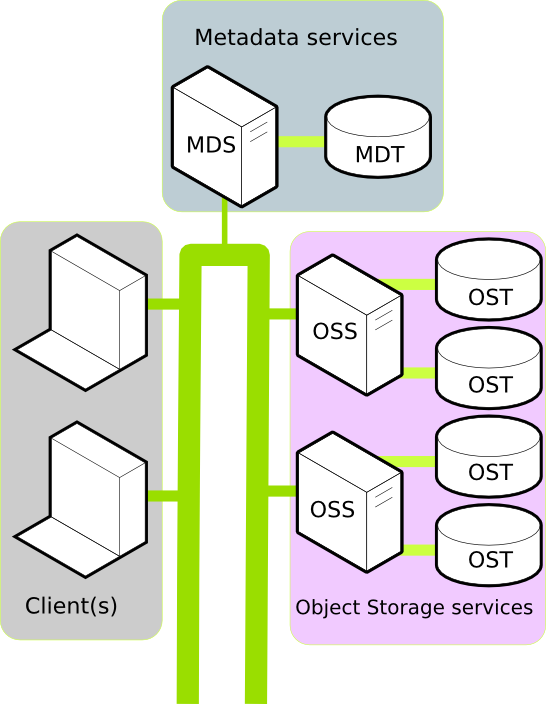Page History
A Lustre file system consists of a number of machines connected together and configured to service filesystem requests. The primary purpose of a file system is to allow a user to read, write, lock persistent data. Lustre file system provides this functionality and is designed to scale performance and size as controlled, routine fashion.
In a production environment, A Lustre filesystem typically consists of a number of physical machines. Each machine performs a well defined role and together these roles go to make up the filesystem. To understand why Lustre scales well, and to consider if Lustre is suitable in your use case, it is important to understand the machine roles within Lustre. A typical Luster installation consists of:
- One or more Clients.
- A Metadata service.
- One or more Object Storage services.
Client
A Client in the Lustre filesystem is a machine that requires data. This could be a computation, visualisation, or desktop node. Once mounted, a Client experiences the Lustre filesystem as if the filesystem were a local or NFS mount.
Further reading:
Metadata services
In the Lustre filesystem metadata requests are serviced by two components: the Metadata Server (MDS) an Metadata Target (MDT). Together, the MDS and MDT service requests like: Where is the file XYZ? I'm going to write to file ABC so prohibit anyone else from using it.
All a Client needs to mount a Lustre filesystem is the location of the MDS. Currently, each Lustre filesystem has only one active MDS. The MDS persists the filesystem metadata in the MDT.
Further reading:
Object Storage services
Data in the Lustre filesystem is stored and retrieved by two components: the Object Storage Server (OSS) and the Object Storage Target (OST). Together, the OSS and OST provide the data to the Client.
A Lustre filesystem can have one or more OSS. An OSS typically has between two and eight OSTs attached. To increase the storage of the Lustre filesystem, additional OSTs can be attached. To increase the bandwidth of the Lustre filesystem, additional OSS can be attached – provided the connection to the Client is not saturated.
Further reading:
Additional Services
Lustre includes additional services including LNET. LNET is designed to simplify configuration of a Lustre filesystem over complex network topologies.
Further reading:
Tools
A Lustre filesystem uses modified versions of e2fsprogs and tar. Managing a large Lustre filesystem is a task that is simplified by community and vendor supported tools. Details of these tools are available at the COMMUNITY PAGE OF THE WIKI
Practical considerations.
Lustre currently has two actively developed and maintained branches. These the are 1.8.x and 2.1 releases. Lustre 1.8.x is used in production environments around the world. It is mature and stable. Lustre 2.1 introduces SMP scaling enhancements to exploit machines with large numbers of sockets, cores and threads. The Lustre 2.1 release is scheduled at the end of Q2, 2011.
The Metadata Server (MDS) is crucial to overall performance of the Lustre filesystem. Increasing memory on the MDS will increase the cache available and increase performance. It is common to see production MDS machines boast 24GB or 48GB per core.
If your environment is biased toward heavy write, or fast write operations, 16GB is recommenced per Object Storage Server (OSS). If reading is of primary concern, increasing OSS memroy to 48GB will enable significant read caching and greatly increase performance.
Further reading
- Notes from the Lustre Centre of Excellence at Oak Ridge National Laboratory
- Understanding Lustre Filesystem Internals white paper from National Centre for Computational Sciences.
